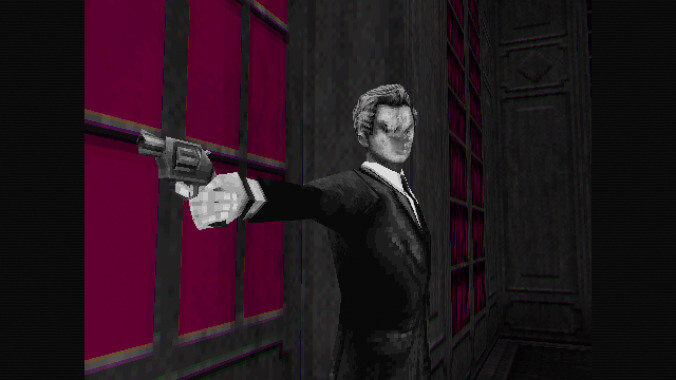Puzzles are a kind of analog telepathy. The puzzle designer conceives of an idea, and then attempts, through the expression of their work—a maze, a cipher, an encoded message or cleverly hidden clue—to export that idea to someone else’s head, in as clean a fashion as possible. It’s the same process that happens in nearly any artistic endeavor, really, except made more direct and pure: Puzzles, unlike stories, have solutions, essentially demanding that you follow the designer’s intent all the way to the finish line. That can make them limiting, but it also makes them a strangely communal and connected experience. (For all that puzzle solving tends to be a nerdy and solitary act.) When it goes right, it gives the solver an incredible feeling of connecting, on a perfect level, with the designer’s hidden intent, of seeing things through their eyes.
The first thing that will strike most Lorelei players, though, aren’t those lofty thematic ideas, or even the game’s tidal wave of lateral thinking problems, math puzzles, mazes, perspective tricks, and more. No, that would be the game’s aesthetics: A deeply appealing grayscale shot through with occasional traces of red, creating the ominous landscape of an abandoned European hotel. Moving with deliberate slowness through these gorgeously realized environments, the woman slowly begins unraveling a tragedy that occurred there in the distant past, piecing together diaries, esoteric art exhibits, and a few straight up “Fun With Numbers!” puzzles to slowly unlock the massive house. A few light supernatural elements, and the game’s largely quiet soundscape, paint a thin patina of horror over the whole thing, but the overriding tone is one of mystery—whether it’s deciphering the events of a strange film project that seems to have killed everyone involved in it, or just trying to figure out what the hell you’re supposed to do with all these damn Roman numerals and padlocks that are floating about all over the place.
Which is as good a time as any to embark on the topic of frustration, and Lorelei’s comfort with letting the player stew in it. This is a puzzle game of unforgiving character: No hint system, no in-game nudges, and the frequent sensation of pushing your brain against a wall and waiting for one or the other to give. (Or for the urge to look up a solution on the internet to become overwhelming, although in its pre-release environment, we were forced to resort to the slower, but more satisfying route of sleeping on whatever brainteaser had most recently left us stumped.) This is a game that has the confidence to say “No, you’ll get it, try again,” and never blink on that score; your willingness to live with the frustration of those moments, in the knowledge that the eventual moment of epiphany will be a worthwhile payoff, will determine how well the game hits for you. As to difficulty, puzzle solving is a very individual thing, but we found most of the game’s conundrums to be ultimately fair; like many great puzzles, the work comes mostly in creating new connections, rather than algorithmically solving some taxing mental process. (The various mazes that dot the game, for instance, aren’t designed to be punishing as mazes, but as platforms for other kinds of conundrums to be solved.)
A few elements probably push the difficulty too far, though, most notably a refusal to auto-save player progress that ties into an odd death mechanic that gets introduced a few hours into your explorations. The idea of these sequences, which crop up about once an hour, is to induce tension, to make you have moments of genuine worry about how much progress you might lose. And this works, to an extent; we can’t deny the thrills these moments created. Even so, threatening a player with having to do stuff they’ve already done isn’t an especially inventive form of video game punishment, and the introduction of “threat” into a meditative puzzle experience, while thematically on-point for a game about the dangers and thrills of losing yourself in introspection, is one place where Lorelei probably indulges itself too far.
Other instances of self-indulgence are mostly just joys, though, including Easter egg references to Simogo’s other games, and a series of areas that deliberately call back the aesthetics of the PlayStation One era horror games that Lorelei is clearly hoping to mimic. (You could argue that the entire game is essentially about exploring a version of the Resident Evil mansion where all of the zombies have been replaced with even more padlocks.) Many of this things—and, slightly irritatingly, the ability to run—are gated behind collectibles found in the environment, giving players some incentive to poke at the corners of the house even more than they already were, and adding a very small amount of replay value to what is, otherwise, probably a one-shot game.
All of this runs in concert with the game’s story, which, while a little slight, is rich with artistic subtext, as you slowly assemble the tragedy surrounding The Third Eye—which is either an abandoned Italian art film from the 1960s, a groundbreaking computer game, or a magical meteor that slammed into the earth back in the prehistoric era, depending on who you ask. The basic ideas explored here might be fairly simple—the tragedy of genius, the battle between artist and audience, the demands between artistic inspiration and the grubby world of cash—but by having you walk through their consequences, slowly break deeper into their mysteries, retrace their thought processes to solve that next puzzle, Lorelei accomplishes the magician’s trick of making you think like its characters, just a little bit. To solve a game like this, it argues, you must first understand it—and in understanding it, you must take its ideas into yourself, if only for a moment. The end result is one of the most satisfying puzzle games in recent years, a pure expression of the form, to ends both frustrating, and divine.

